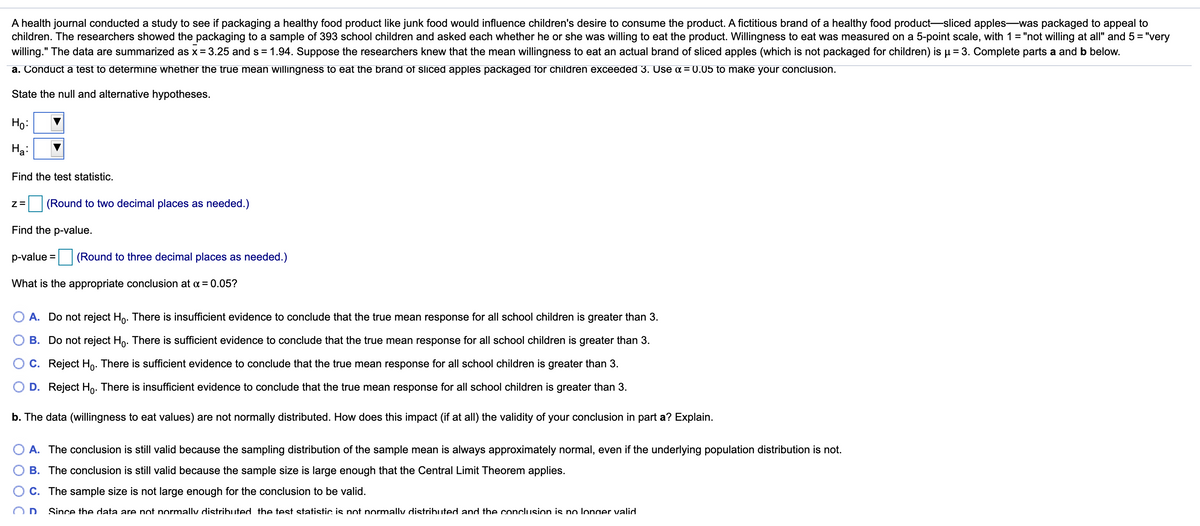A health journal conducted a study to see if packaging a healthy food product like junk food would influence children's desire to consume the product. A fictitious brand of a healthy food product-sliced apples-was packaged to appeal to children. The researchers showed the packaging to a sample of 393 school children and asked each whether he or she was willing to eat the product. Willingness to eat was measured on a 5-point scale, with 1="not willing at all" and 5= "very willing." The data are summarized as x= 3.25 and s= 1.94. Suppose the researchers knew that the mean willingness to eat an actual brand of sliced apples (which is not packaged for children) is u = 3. Complete parts a and b below. a. Conduct a test to determine whether the true mean willingness to eat the brand of sliced apples packaged for children exceeded 3. Use a = 0.05 to make your conclusion. State the null and alternative hypotheses. Họ: Ha: Find the test statistic. z= (Round to two decimal places as needed.) Find the p-value. p-value = (Round to three decimal places as needed.) What is the appropriate conclusion at a = 0.05? O A. Do not reject Hp. There is insufficient evidence to conclude that the true mean response for all school children greater than 3. O B. Do not reject Hp. There is sufficient evidence to conclude that the true mean response for all school children greater than 3. O C. Reject Hg. There is sufficient evidence to conclude that the true mean response for all school children greater than 3. O D. Reject Hg. There is insufficient evidence conclude that the true mean response for all school children greater than 3 b. The data (willingness to eat values) are not normally distributed. How does this impact (if at all) the validity of your conclusion in part a? Explain. O A. The conclusion is still valid because the sampling distribution of the sample mean is always approximately normal, even if the underlying population distribution is not. O B. The conclusion is still valid because the sample size is large enough that the Central Limit Theorem applies. Oc. The sample size is not large enough for the conclusion to be valid. OD Since the data are nnt normallu dietrihuted the test statistic is not normallv dietrihuted and the conclusion is no Innner valid
Inverse Normal Distribution
The method used for finding the corresponding z-critical value in a normal distribution using the known probability is said to be an inverse normal distribution. The inverse normal distribution is a continuous probability distribution with a family of two parameters.
Mean, Median, Mode
It is a descriptive summary of a data set. It can be defined by using some of the measures. The central tendencies do not provide information regarding individual data from the dataset. However, they give a summary of the data set. The central tendency or measure of central tendency is a central or typical value for a probability distribution.
Z-Scores
A z-score is a unit of measurement used in statistics to describe the position of a raw score in terms of its distance from the mean, measured with reference to standard deviation from the mean. Z-scores are useful in statistics because they allow comparison between two scores that belong to different normal distributions.
A health journal conducted a study to see if packaging a healthy food product like junk food would influence children's desire to consume the product. A fictitious brand of a healthy food
packaged to appeal to children. The researchers showed the packaging to a sample of
school children and asked each whether he or she was willing to eat the product. Willingness to eat was measured on a 5-point scale, with
willing at all" and
willing." The data are summarized as
and
Suppose the researchers knew that the mean willingness to eat an actual brand of sliced apples (which is not packaged for children) is
Complete parts a and b below.

Trending now
This is a popular solution!
Step by step
Solved in 2 steps with 1 images






